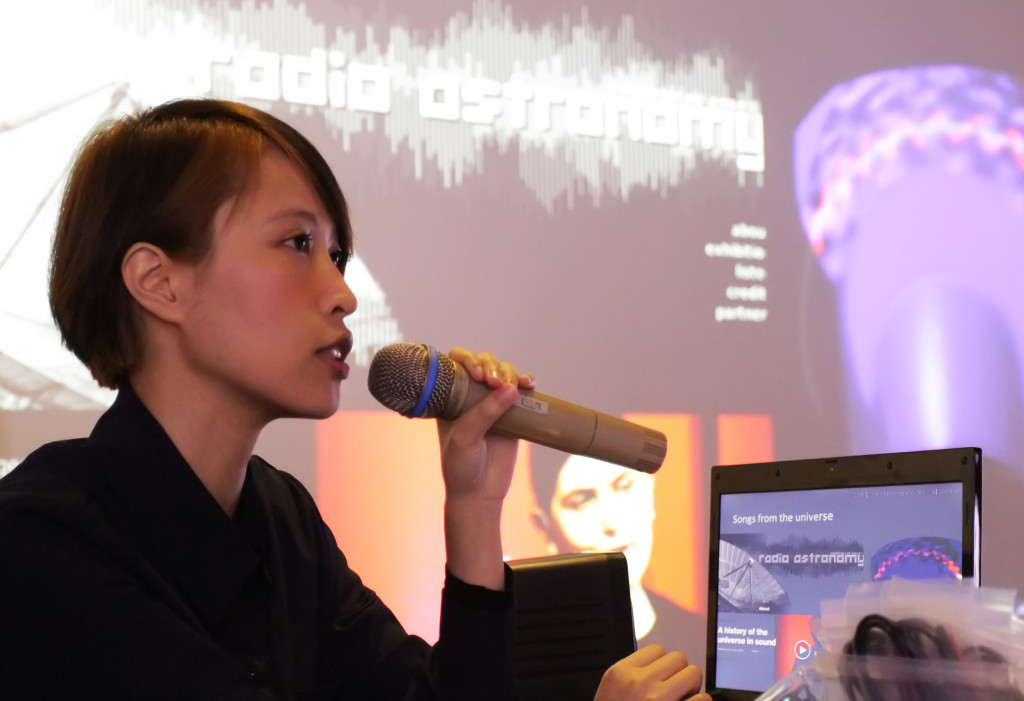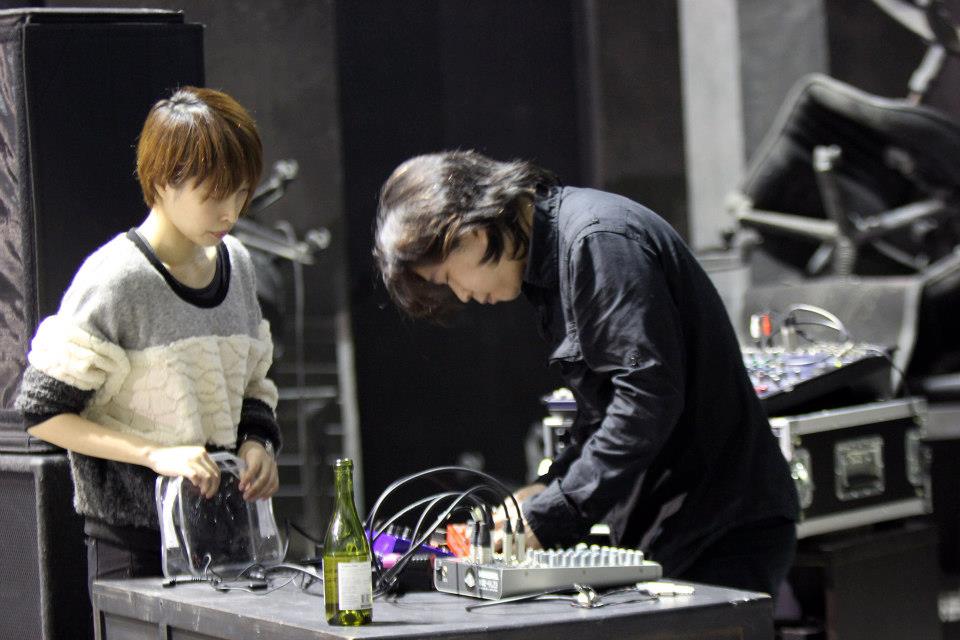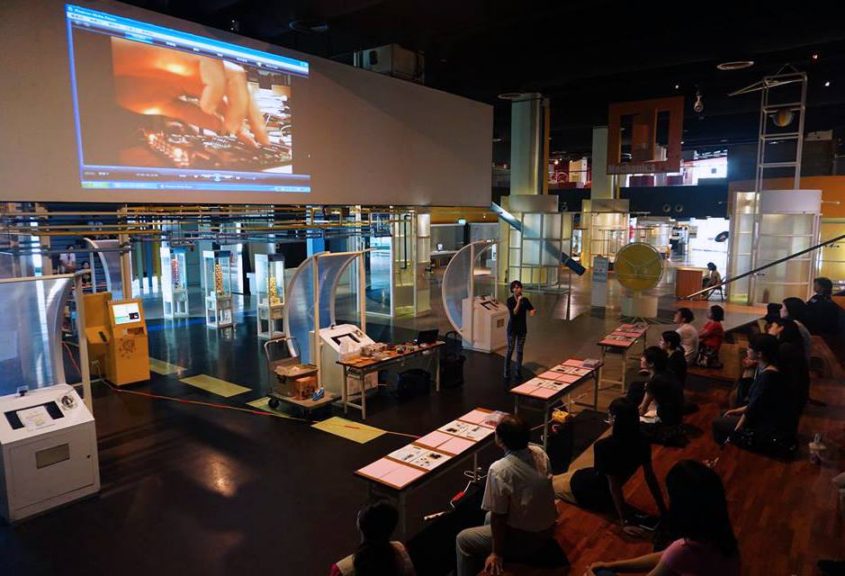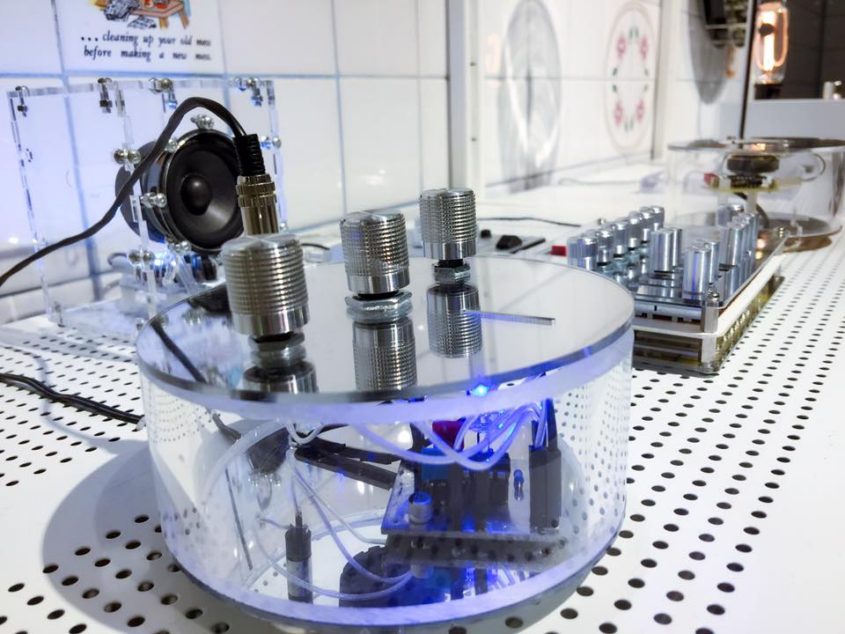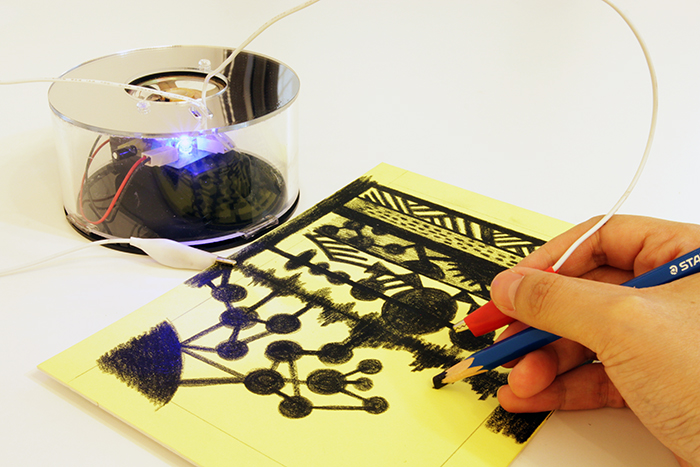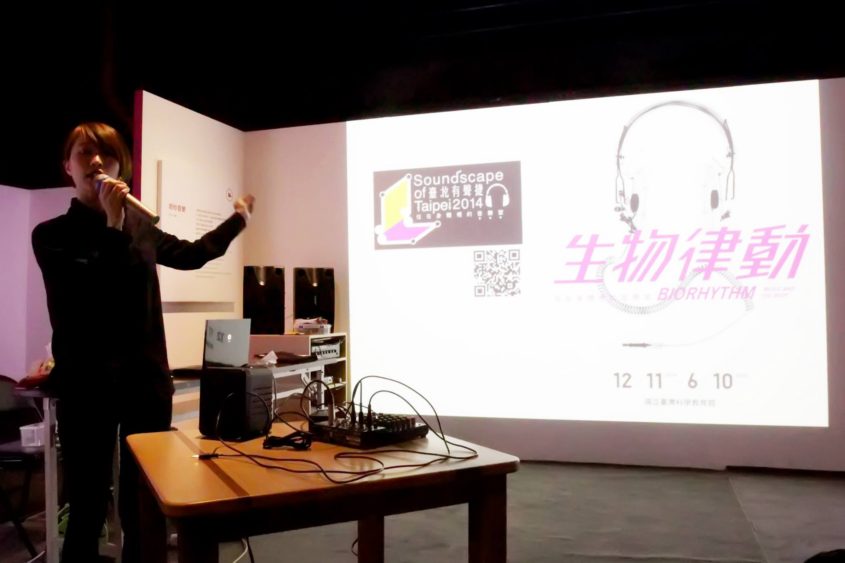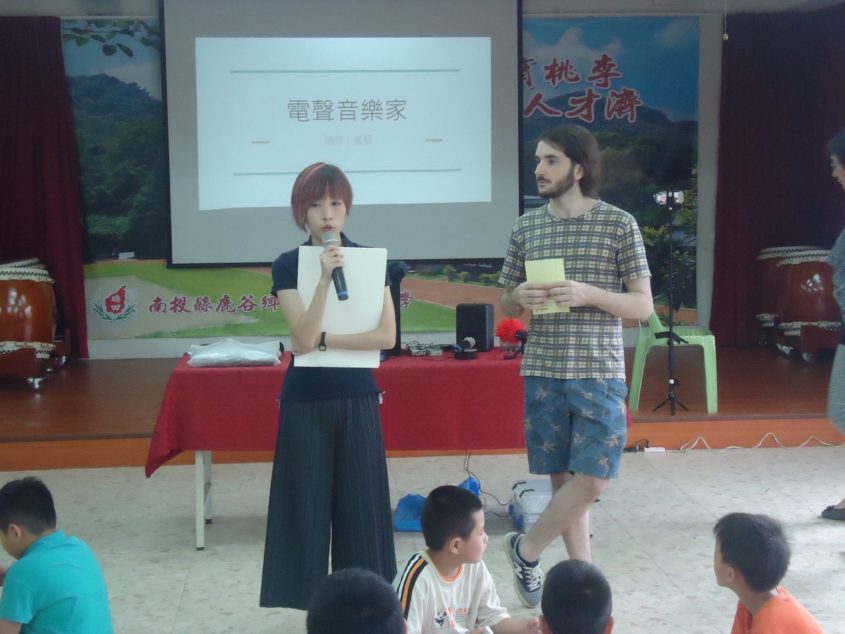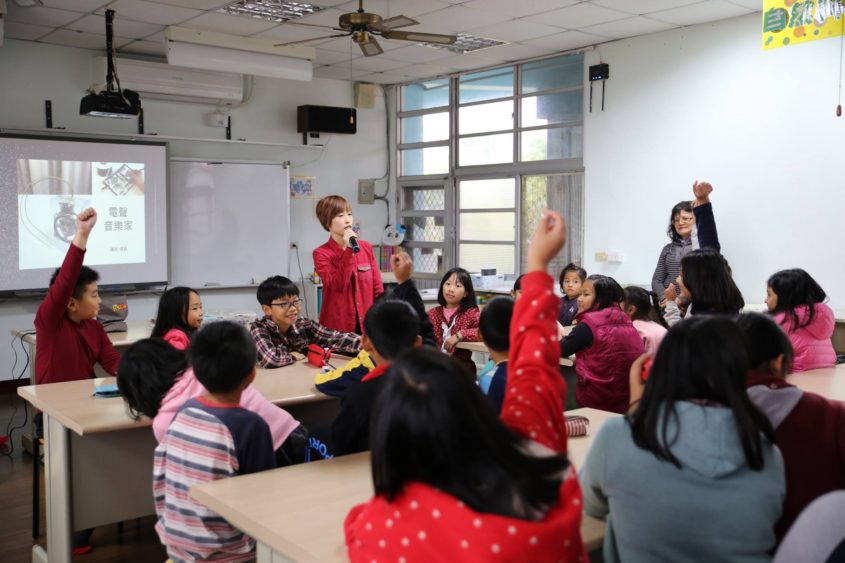藝術家教師
文章:沈怡君
攝影:謝華玥
感謝:胡子哥 Gabriele de Seta
你聽過或是見過藝術家教師嗎?藝術家教師究竟是教師,還是藝術家?在回答這個問題前,也許可以透過閱讀下面一段文字,再進行思考。
藝術家教師在英語可以譯作“Teaching Artist”或是“Artist-Teacher”藝術家教師的定義因應社會日新月異不斷改變,美國藝術教育文獻對於使用“Artist-Teacher”可以追溯至1950年代,當時對於形容藝術家教師有著不同的看法。一方教育者爭論藝術家的創作本質,對於成為藝術老師是不可或缺的(McCracken,1959);另一方則描述“Artist-Teacher”只是一個膚淺的詞彙,不但會使教學注意力分散,亦和一個專業藝術家毫無關係(Lanier,1959)。
換句話說,藝術家因為無法成為傑出藝術家,才退而求其次的進行教學工作嗎?盧藝的故事,或許可以為這個想法提供一些新的詮釋。
走入聲音藝術
因為出身教育世家,理所當然地唸了師院、修了教程和拿到教檢,獲得教師資格後,卻對一直流浪代課生涯的未來感到困惑,來回代課流浪幾回合後,在人生進入而立之年時,毅然決然轉換身份投入一個全新的領域,「不想再為世俗的框架和社會的期待而活,教師證對於不走教職而言只如同是一張廢紙,如果不當老師到底還可以挑戰什麼?」這是盧藝掛在嘴上的一句話。2011年因緣際會下走進了另外一個世界,將及腰的長髮剪下,換上全黑的工作服,走在台灣聲音藝術教父王福瑞老師身邊,從行政、設計、記錄、作品助手開始走上未知的藝術家道路。
重回教學現場
從一次的福瑞助教經驗學到關於Atari punk console的電路知識,盧藝開始有了一些想像,能不能在工作忙碌之餘,動手做一些讓自己覺得有趣的東西,或許也是內心老師的經驗引領,她利用同樣的電路原理,加上不同電容、光敏電阻與壓克力鏡面外殼,做出了像是教具般的噪音小樂器。
2013年底王福瑞在當代館展出個展’’超傳波’’,展覽要搭配一個藝術家工作坊,盧藝自告奮勇代替上場,她說:「當時聽到有這個機會眼睛都亮了,有機會上場用老本行跟大家解釋什麼是聲音藝術,因為很多人對”聲音藝術”感到陌生又好奇,以為藝術品只要有聲音就算是了。所以提案希望把很受歡迎的簡易合成器Atari punk console電路(簡稱APC)*註一,以半成品電路板方式與DIY組裝與相關聲藝作品欣賞,呈現在’’超傳波’’展的工作坊中。」
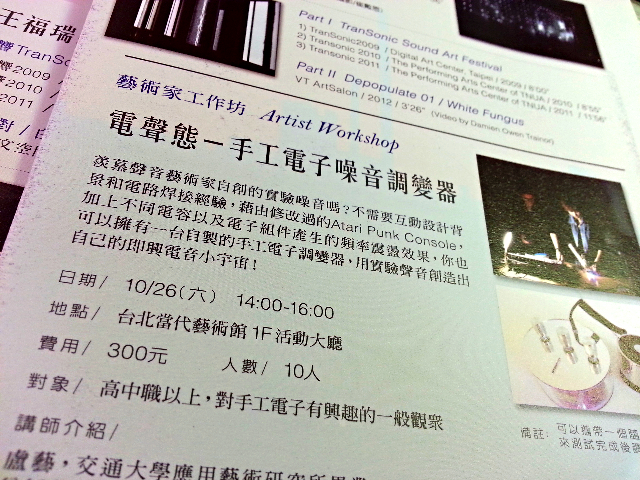
盧藝的工作坊開始有了來自其他單位的邀請,結合以前的教育經驗,後學的新媒知識,盧藝接了一場又一場的工作坊。也開啟了與立賢基金會的偏鄉教育合作計畫,在兩年內跑了28間的偏鄉小學,使用APC變化版本*註二,進行聲音畫畫的體驗。盧藝說:「進到偏鄉國小,聲音藝術這東西是音樂還是藝術還是什麼,詮釋和解說都會是掛在隻身來校的我身上,畢竟國小相關領域比較沒機會碰觸到這些,但又不能講得太枯燥太學術,以免孩子內心對聲音藝術覺得難又無聊的負面印象,所以我準備了一顆電漿球,用電磁波麥克風收音,可以摸著電又聽到電的聲音,來開啟很酷的課程起頭,另外搭配遊戲、繪畫和笑話一邊進行課程,希望可以讓他們覺得聲音藝術是個超好玩的主題,也是一種不同的音樂或藝術欣賞方式。」

另一種聲音藝術
「很多聲音藝術家都以現場表演和展覽作品的方式居多,得到的關注通常會比較即時,也會比較有當藝術家的成就感。當然聲音藝術的表現方式很多元,我選擇用教育呈現我的想法,當然帶很重的喇叭設備和教具,連續上一樣的內容但需要保持新鮮有趣,忙完福瑞工作隔天就緊接著搭車到偏鄉上課,上完課又回到忙碌的助手工作,對我也是個體力考驗,但就這麼次次累積下來,也變成一股力量……」
緣份讓盧藝放下了教師身份,卻也繞了一圈,用她自己的方式再一次回到教學現場,當代藝術館、街大歡囍、科學教育館、台中勤美誠品和高雄衛武營等…都可以看見感染到聲藝魅力,因而相繼邀約所開設的工作坊,一年一年,從未間斷。更重要的是,盧藝將大眾所不熟悉的聲音藝術推得更廣,用一套畫畫與聲音的小樂器。經過不斷地推廣,盧藝得到的資源和認同也越多,經由好友謝華玥的攝影與來自義大利主修人類學的胡子哥協同參與,加上原是同事的沈怡君,三人運用各自不同背景與專長,跟著盧藝一同進入偏鄉,記錄和推廣聲音藝術。
「教學就像表演,觀眾反應都會反饋到自己。」經過琢磨,盧藝將自身教育背景與新媒體藝術共構,將理論、實作、玩耍三者結合,透過立賢基金會的支持,盧藝轉化在大學校內的課程,在偏遠地區的教室裡才感受得到,並不是當初身為教師的身份因而在教學現場中如魚得水,而是以藝術家教師的身份,透過自創教案與教學實踐,深入了解感受不一樣身份的自己,同時與孩子們共同成長。
回過頭來看,Association of Teaching Art 將“Teaching Artist”一詞定義為:一名實務專業的藝術家,具有技能與教育者的知覺,他們吸引人們學習有關藝術、在藝術中學習,與透過藝術學習。盧藝所做的一切,不正是如此嗎?沒有人能夠知道未來的道路是否永遠順暢,倘若願意給自己短暫的人生一個機會,也許,可以試著相信心之所向,重新感受到自己的溫度。
(文獻整理自: G. James Daichendt,2010)
*註一:APC:Atari punk console是一個網路熱門的手工電子合成器電路,原始設計來自美國科學家Forrest Mims的所發表的’’stepped tone generator’’電路,幾年後這套電路首次以修改過的版本(line level輸出)發表在’’caustic machines’’網站,名稱為Atari punk console,也因為聲音類似Atari 2600 家用電玩主機,所以為Atari,punk是龐克,龐克風格都見有DIY的影子,所以使用 punk代表DIY的精神。而console有控制台的意思。該核心電路IC使用號碼555或556的晶片,晶片產生方波型的聲音震盪,發出具電玩主機的lo-fi音效,另外有兩個可變電阻可以調變出聲音變化,而網路上有許多教學影片,可以經由自學完成屬於自己的版本。
*註二:APC變化版本:盧藝使用556作為她所有教具的IC晶片,搭配透明喇叭,自製的鉛筆來替代電路中其一個可變電阻,加上換成自己實驗過選擇的電容,在紙上鉛筆所畫出的不同距離和深淺產生不同電阻值,透過皮膚的膚電反應,此樂器教具讓孩子可以一邊畫畫一邊玩聲音。
“I don’t want to live in the conventional frame or for the expectation of the society. Teaching certificate means nothing if you don’t teach. If not, what challenge to take?” Yi Lu often says.
In 2011, Yi Lu entered another world by chance. She had her long hair cut short, wore entirely black work clothes and followed Fujui Wang, the godfather of Taiwan’s Sound Art. From administration, design, documentation to co-creation, she stepped onto an unknown path of art. She acquired knowledge of circuit about Atari punk console(APC) by helping Wang in a teaching session and began to imagine: maybe she could do something interesting in her leisure time. Perhaps due to her inner experience as a teacher, she employed similar circuit principles and replaced with different capacitances and photoresistances to create hand-made teaching tools.
By the end of 2013, Fujui Wang held a solo exhibition in MOCA Taipei titled “HYPER TRANSMISSION” which required an artistic workshop. Yi Lu audaciously volunteered, “When I heard this, my eyes were wide open. I’ve always wanted to have the chance to explain sound art to the public. For many people, Sound Art is unfamiliar yet it arouses curiosity. People think works with sound belong to the genre. So I proposed to represent basic APC circuits in the form of raw products in the workshop of ‘HYPER TRANSMISSION’”.
Other organizations began to invite Yi Lu to make workshops. Combining her previous teaching experience and knowledge of hand-made circuits she learned later, she undertook workshops one after another. One of them resulted in a long term collaboration project with the Shiner Education Foundation. Within two years, she took her workshops into more than 30 primary schools. According to Yi Lu, “Since primary schools don’t teach Sound Art, when I was invited to talk about it, I had to explain all the questions about whether it’s music or art or anything else, all by myself. I also had to avoid too boring and academic aspects so the pupils wouldn’t feel it’s difficult, dull and get a negative idea of it. So I prepared a plasma ball and recorded sounds with electromagnetic pickup microphones so the electronic thing became palpable and audible. Starting with the cool stuff, I then combined games, pictures and jokes as the course proceeded, hoping that Sound Art became rather fun and they’d consider it to be another way of appreciating music or art.”
“Many sound artists present works mainly through live performances or exhibits, attracting immediate attention and getting a sense of achievement as artists. There are certainly many ways to express Sound Art. I chose to express my idea through education, carrying quite heavy speakers and teaching tools. While the content of the course remains the same, I need to refresh it all the time. And I move between art-making and teaching in the countryside by taking special shuttles. The tight schedule and workload proves to be a physical challenge as well. Yet by doing again and again, I came to develop a certain strength……”, Yi Lu recalled. If destiny drove Yi Lu to move away from teaching, she eventually returned to the class after a long run. Thus she consistently got invitations to make workshops. Moreover, Yi Lu further promoted the unfamiliar Sound Art by means of a set of small instruments to draw and make sound. The steady endeavor also earned more resources and recognitions. Then, close friends like Vivy as photographer as well as Gabriele de Seta joined her, added ex-colleague Yi Chun Shen who helped teaching. They use their respective know-how to document and spread Sound Art along with Yi Lu. “Teaching is like performance, the audience’s response becomes a feedback to you.” Yi Lu integrates her teaching background and new media art, fusing theory, practice and games. With the Foundation’s support, she makes efforts to actualize the challenges she aim for, acquiring a special place of her own in the realm of Sound Art.
更多
胡子哥 http://paranom.asia/about/
